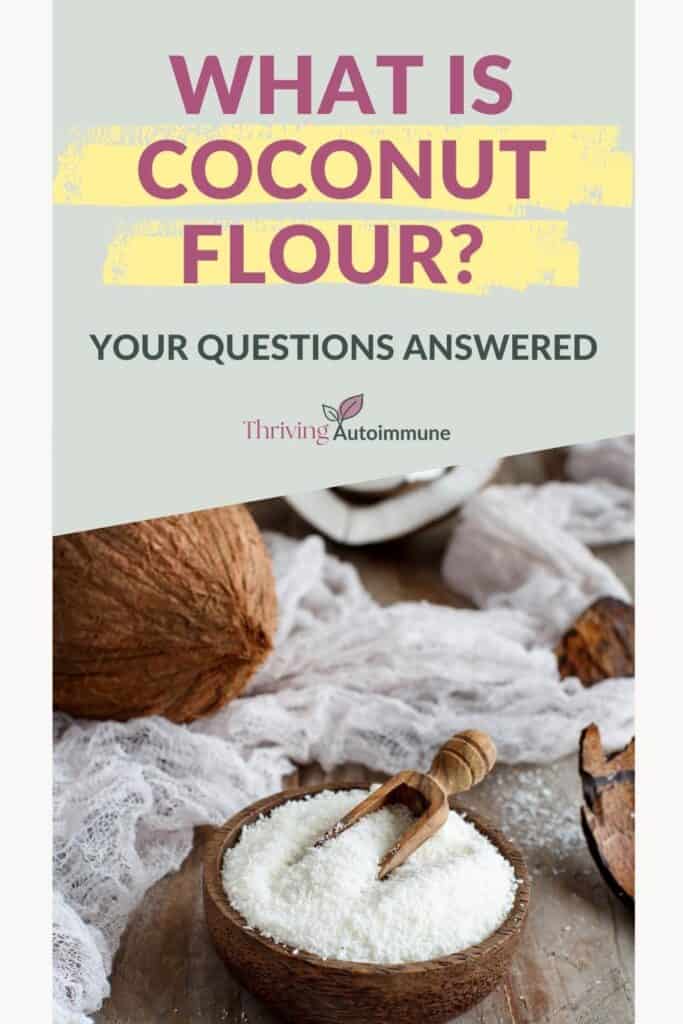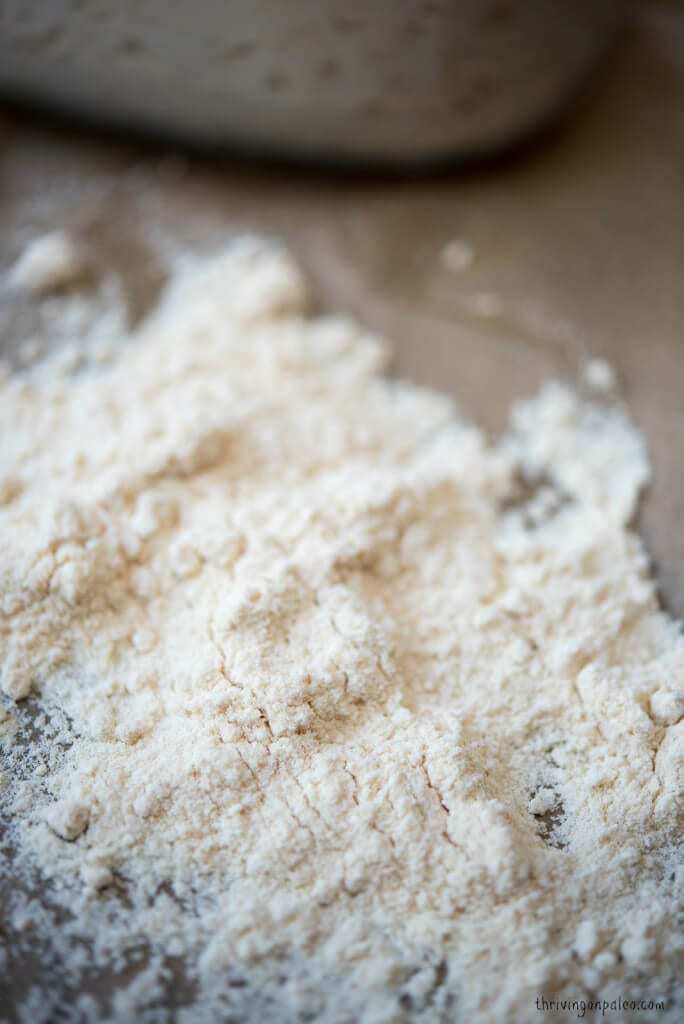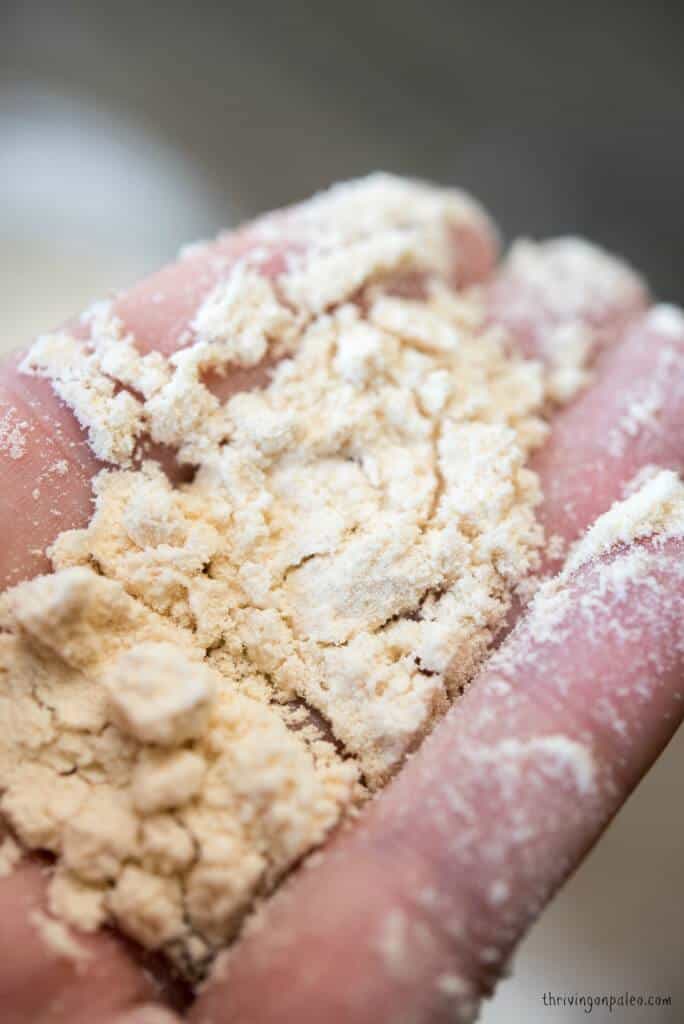This post may contain affiliate links. Please read my disclosure policy.
Coconut flour – it's such a unique flour that's so different from any other flour out there, whether all-purpose wheat flour or even the grain-free flours. In this post I answer all of your burning questions – What is coconut flour? What is it made of? What are the benefits? Can you substitute it for all-purpose flour? Or any other grain-free flour? How do you bake with it? All of this is answered and more!

I remember when I first dabbled in the grain-free world that I was confused and overwhelmed by all of the new ingredients. It was almost like starting ALL over again with baking and I honestly had no idea what some of the ingredients were.
So to help any of you that might be confused in all of this Paleo mumbo jumbo, I want to clear things up and help you to understand what these ingredients are.
The first Paleo ingredient I want to clear up is coconut flour.
I chose this one because it was the very first grain-free flour I had experience with and it’s probably the least similar to wheat flour, therefore a bit of a mystery when you don’t know how to use it.
What is coconut flour?
Coconut flour is actually just ground up dried coconut meat. Simple, right?
It's a naturally gluten- and grain-free flour that is used a lot in gluten-free and grain-free diets like Paleo, AIP, GAPS, and SCD.
You can make it at home if you want using shredded coconut – in fact if you make your own homemade coconut milk, all you have to do is dry the pulp in an oven or dehydrator and then ground it up in a blender or food processor.
I typically just buy mine online though for the convenience (I have been using Anthony's because it's inexpensive and I love the consistency).
It should be a kind of creamy, off-white colored powder with some clumps in it. It, amazingly enough, doesn’t taste very coconutty, which is great when you are trying to make a pumpkin muffin and don’t want it to be a “coconut” pumpkin muffin.
What are the benefits?
It is super high in fiber, ringing in at 11 g of fiber per ounce, which actually makes it the highest fiber of any flour, and may help your digestion.
NOTE: The majority of this fiber is a type called inulin fiber, a prebiotic – which may help your digestion but also can cause gas, bloating, and other GI symptoms in some people. If you eat a coconut flour baked good and experience any of these symptoms afterwards, you may want to either avoid it or start with smaller amounts and work up to more.
There is also some protein in this flour, ranging from 4-6 g per ounce, which I have found causes me to get fuller off of less (the fiber probably plays a role in this too).
For example, if I have maybe 2 small silver dollar sizes coconut flour pancakes I am satisfied.
Whereas back in my wheat flour days I’d have to have a plate-sized stack. And even when I have almond flour pancakes I seem to want more than I do with coconut flour ones.

How much does coconut flour cost?
If you are used to buying regular all-purpose wheat flour, you might be a bit shocked at the sticker price of coconut flour.
I did a quick cost comparison and my fave brand of coconut flour, Anthony's is currently $10.99 on Amazon for a 4 lb bag and my old fave AP flour on King Arthur Flour is $3.99 for a 5 lb bag.
So yes, it is definitely more expensive than regular AP flour.
However, you don't NEED as much coconut flour for most recipes as you would an AP flour.
You probably use roughly ¼ of the amount of coconut flour than you would with a wheat-based flour, so it’s not nearly as bad if you multiply that bag of wheat flour’s price by 4.
How do you use coconut flour?
One thing to note is that it's is a pretty dense flour that soaks up liquid like a sponge.
This can be an advantage because you don’t need to use as much of it. But if you don’t get the ratio of liquid correct it can be extremely dry.
Because you use a lot less of it than you do with wheat flour, and because it is such a thirsty sucker, you need to use it a lot differently than you would with regular wheat flour.
You'll most likely use LOTS of Liquids
LIQUID is going to be your best friend in baking. Usually, this will come in the form of eggs, but sometimes dairy-free milk is used as well.
TIP: When baking you generally will want about 1 egg to 1 ounce of coconut flour.
The amount of liquid to coconut flour can range quite a bit depending on other ingredients you are using and sometimes you need additional liquid and sometimes you don’t (like my AIP Lavender Shortbread Cookies, for example, have NO liquid nor eggs).
So as a result, I recommend that if you are new to this whole coconut flour baking thing, use some tried and true recipes first and then start experimenting with ratios a bit.
One recipe that adheres to the typical need for eggs is this one that I've loved for years: Grain-free Coconut Flour Waffles recipe by Cara Comini of Health, Home, & Happiness
Sift the flour
Because it can be clumpy I also recommend that you either sift it (I just use a regular wire mesh colander), whisk it, or break up the big clumps with your hands before adding to your recipe.
It's not fun biting into a warm muffin and getting a big clump of dry dry coconut flour.
Spoon, not pour the batter
Once you add it to the other ingredients I also recommend mixing pretty well. You'll notice at first your batter looks very liquidy, and then a few minutes later it will look dry and really thick. This is the magic of the sponge-like effect.
You'll also notice that it is very sticky and doesn’t pour like other batters will. Most times you will have to take a spoon and scoop bits of the batter into your muffin tins, bread pan, griddle, etc and then flatten down a bit.
Rest assured it will still puff up and bake like a typical baked good would, but it’s a bit disconcerting the first few times making it.
Can you substitute coconut flour for all-purpose flour? (Or almond flour, cassava flour, tapioca flour, etc)
The short answer to this is NO. You cannot substitute 1 for 1 for any other flours, regular AP or grain-free.
It's all because of that sponge-like effect. If you were to substitute 1:1 your baked good would come out extremely dense and dry.
You'll notice that many recipes call for either small amounts (typically 1/4 cup or less) of coconut flour, or a mixture of flours, where you only add 1-2 tablespoons of coconut flour. This is because most recipe developers have found that the texture and consistency of results in baked goods come out better with this mixture.
So definitely don't go replacing that almond flour with coconut flour 1:1.
Can you use coconut flour other than baking?
Yes! It works in non-baking recipes as well.
And in some applications, like a coating on some fish or chicken, you can break the whole “Heck no you can't you substitute coconut flours for other flours” rule!
You can use 1:1 for regular flour or other grain-free flours when coating meats.
Quick Paleo and Whole30 dinner idea: Mix ½ cup of coconut flour, a pinch each of sea salt, pepper, garlic powder and paprika into a bowl. Dredge 1-2 lbs boneless, skinless chicken breasts or thighs in a beaten egg, then dip it in the flour mixture, shake off the excess and then cook in a pan with melted coconut oil until done (flipping once).
A quick AIP Diet dinner idea (also Paleo and Whole30): is to mix up 1/2 cup of coconut flour with a pinch each of sea salt, garlic powder, and Italian Herbs. Then dip 1-2 lbs of 1-2 lbs boneless, skinless chicken breasts or thighs in approx 1/2 cup of coconut milk, then dip it in the flour mixture, shake off the excess and then cook in a pan with melted coconut oil until done (flipping once).

Where to buy Coconut Flour
I typically buy mine from Amazon – I like the Anthony's brand.
I used to get Tropical Traditions, which is also great, but it was twice as expensive. Either one is very consistent in quality and “clumpiness” so I know what to expect.
There are also brands now in the grocery stores and even at Costco that I have noticed, typically in the baking aisle, and often in the “alternative ingredients” section (like where the Bob's Redmill stuff is).
I encourage you to try a few different types and find one that you like.
Recipes Using Coconut Flour
AIP Lavender Shortbread Cookies (Paleo, AIP)
Paleo Roasted Strawberry Muffins (nut-free)



This is so helpful! Coconut flour can be tricky! I will be pinning this to share with folks that ask about how to use coconut flour! Thank you!
Thanks Renee!